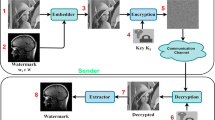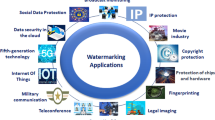Abstract
This paper presents a novel semi-blind watermarking scheme in which a balanced neural tree (BNT) is exploited for embedding and extracting the watermark. The BNT is trained to learn the watermark and the synapses (optimal weights) of the trained BNT are embedded in the host image instead of watermark image. As a result, the proposed scheme is able to embed a large size of watermark in the host image. In the watermark extraction phase, the embedded synapses are extracted from the transmitted image and then watermark is recovered from these extracted synapses. In this way, the original image is not required in the extraction phase. The proposed scheme is tested to withstand various kinds of attacks and found to be robust against various image processing and geometrical attacks.




















Similar content being viewed by others
References
Bao J, Yang Q (2012) Period of the discrete arnold cat map and general cat map. Nonlinear Dyn 70(2):1365–1375
Celik M, Sharma G, Saber E, Tekalp AM (2002) Hierarchical watermarking for secure image authentication with localization. IEEE Trans Image Process 11(6):585–595
Chang CH, Ye Z, Zhang MY (2005) Fuzzy-art based adaptive digital watermarking scheme. IEEE Trans Circuits Syst Video Technol 15(1):65–81
Chang C, Wang H, Su S (2010) Copyright authentication for images with a full counter-propagation neural network. Expert Syst Appl 37:7639–7647
Chen F, Wong K, Liao X, Xiang T (2012) Period distribution of generalized discrete arnold cat map for n = p e. IEEE Trans Inf Theory 58(1):445–452
Davis KJ, Najarian K (2001) Maximizing strength of digital watermarks using neural networks. In: Proc. of the international joint conference on neural networks, vol 4, pp 2893–2898
Foresti G, Pieroni G (1996) Exploiting neural trees in range image understanding. Pattern Recogn Lett 19(9):869–878
Hsu CT, Wu JL (1999) Hidden digital watermarks in images. IEEE Trans Image Process 8(1):58–68
Joo S, Suh Y, Shin J, Kikuchi H, Cho SJ (2002) A new robust watermark embedding into wavelet DC components. ETRI J 24(5):401–404
Liu JL, Lou DC, Chang MC, Tso HK (2006) A robust watermarking scheme using self-reference image. Comput Stand Interface 28:356–367
Mei SC, Li RH, Dang H, Wang YK (2002) Decision of image watermarking strength based on artificial neural-networks. In: Proc. of the ninth international conference on neural information processing, vol 5, pp 2430–2434
Micheloni C, Rani A, Kumar S, Foresti GL (2011) A balanced neural tree for pattern classification. Neural Netw 27:81–90
Mohan BC, Kumar SS (2008) A robust image watermarking scheme using singular value decomposition. J Multimedia 3(1):7–15
Paquet AH, Ward RK, Pitas I (2003) Wavelet packets-based digital watermarking for image verification and authentication. Signal Process 83(10):2117–2132
Tsai HH, Liu CC (2011) Wavelet-based image watermarking with visibility range estimation based on HVS and neural networks. Pattern Recogn 44:751–763
Tseng HW, Hsieh CP (2008) A robust watermarking scheme for digital images using self reference. Adv Commun Syst Electr Eng (Springer) 4:479–495
Wang Y, Pearmain A (2004) Blind image data hiding based on self reference. Pattern Recogn Lett 25:1681–1689
Wang Z, Bovik AC, Sheikh HR, Simoncelli EP (2004) Image quality assessment: from error measurement to structural similarity. IEEE Trans Image Process 13:600–612
Yua G, Lub CS, Liao MHY (2003) A message-based cocktail watermarking system. Pattern Recogn 36:957–968
Zhang ZM, Li RY, Lei W (2003) Adaptive watermark scheme with RBF neural networks. In: Proc. of the international conference on neural networks and signal processing, vol 2, pp 1517–1520
Zhao D, Chen G, Liu W (2004) A chaos-based robust wavelet-domain watermarking algorithm. Chaos Solitons Fractals 22:47–54
Zhaou B, Chen J (2004) A geometric distortion resilient image watermarking algorithm based on SVD. Chin J Image Graph 9:506–512
Acknowledgment
This research work is supported by Council of Scientific and Industrial Research (CSIR), New Delhi under the grant number CSR-557-MTD.
Author information
Authors and Affiliations
Corresponding author
Rights and permissions
About this article
Cite this article
Rani, A., Raman, B. & Kumar, S. A robust watermarking scheme exploiting balanced neural tree for rightful ownership protection. Multimed Tools Appl 72, 2225–2248 (2014). https://doi.org/10.1007/s11042-013-1528-3
Published:
Issue Date:
DOI: https://doi.org/10.1007/s11042-013-1528-3




